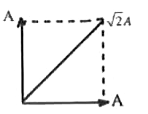Two simple harmonic motions y1=Asinωt and y2=Acosωt are superimposed on a particle of mass m. Find the total mechanical energy of the particle.

Phase difference between the two SHMs is 90∘ Therefore, resultant amplitude is
A=√2AE=12mω2A2R=12mω2(√2A)2=mω2A2
Topper's Solved these Questions
- BOOK - AAKASH SERIESCHAPTER - OSCILLATIONSEXERCISE - EXERCISE I184videos
OSCILLATIONS
- BOOK - AAKASH SERIESCHAPTER - OSCILLATIONSEXERCISE - EXERCISE II175videos
OSCILLATIONS
- BOOK - AAKASH SERIESCHAPTER - OSCILLATIONSEXERCISE - EXERCISE-349videos
OSCILLATIONS
- BOOK - AAKASH SERIESCHAPTER - OSCILLATIONEXERCISE - QUESTIONS FOR DESCRIPTIVE ANSWERS12videos
OSCILLATION
- BOOK - AAKASH SERIESCHAPTER - PHYSICAL WORLDEXERCISE - VERY SHORT ANSWER TYPE QUESTIONS5videos
PHYSICAL WORLD
Similar Questions
Two simple harmonic motions y1=Asinωt and y2 = Acosωt are superimposed on a particle of mass m. The total mechanical energy of the particle is
View Solution(a) A particle is subjected to two simple harmonic motions
x1=A1sinωt and x2=A2sin(ωt+π/3).
Find (i) the displacement at t=0, (ii) the maximum speed of the particle and (iii) the maximum acceleration of the particle.
(b) A particle is subjected to two simple harmonic motions, one along the x-axis and the other on a line making an angle of 45∘ with the x-axis. The two motions are given by
xy=x0sinωt and s=s0sinωt
Find the amplitude of the resultant motion.View Solution
Knowledge Check
- Question 1 - Select One
Two simple harmonic motions y1=Asinωt and y2 = Acosωt are superimposed on a particle of mass m. The total mechanical energy of the particle is
A12mω2A2Bmω2A2C14mω2A2Dzero - Question 2 - Select One
Two simple harmonic motion y2Asinωt and y2=Acosωt are superimposed on a particle of mass m. The total mechanical energy of the particle is:
A12mω2A2Bmω2A2C14mω2A2Dzero - Question 3 - Select One
Two simple harmonic motions y1=Asinωt and y2=Acosωt are supre imposed on a particle of mass m.
A12mω2A2Bmω2A2C14mω2A2Dzero
A particle is subjected to two simple harmonic motions
x1=A1sinωt
andx2=A2sin(ωt+π3)
Find a the displacement at t=0, b. the maxmum speed of the particle and c. the maximum acceleration of the particleView SolutionA particle is subjected to two simple harmonic motions
x1=A1sinωt
andx2=A2sin(ωt+π3)
Find a the displacement at t=0, b. the maxmum speed of the particle and c. the maximum acceleration of the particleView SolutionTwo waves y1=asin(ωt−kx) and y2=acos(ωt−kx) superimpose at a point :
View SolutionTwo simple harmonic motions are given by
y1=A1sinωtandy2=A2sin(ωt+ϕ) are acting on the particles in the same direction .The resultant motion is S.H.M., its amplitude isView SolutionTwo simple harmonic motions are given by y1=5sin(ωt=π/3).y2=5(sinωt+√3cosωt). Ratio of their amplitudes is
View Solution

